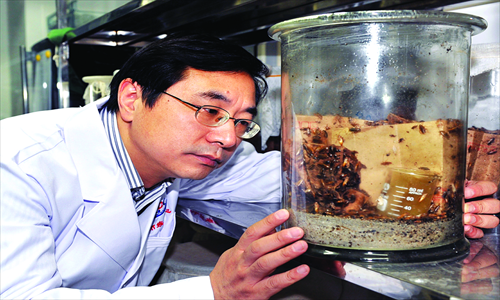The immortal cockroach

The cockroach is perhaps the most notorious insect in the world. It serves as the good model of strong vitality, as it can live in nearly any condition and subsist without food for a fortnight if there is water provided. Most people smash the critter on the spot without a second thought, but Zeng Xiaopeng, or Dr Cockroach, loves to collect them and raise them in his laboratory.
Meet the Doctor
Before entering Zeng's laboratory, you need to have a mask, a pair of gloves and, more importantly, a brave heart. It's basically like any normal laboratory if you exclude the 30-square-meter room where he keeps a collection of insects such as mosquitoes, flies and, of course, his beloved cockroaches.
The buzzing sounds, stinky smells and moist environment all make Zeng's workplace unbearable. For him, eight hours spent studying cockroaches and other pesky insects goes by in the blink of an eye.
Zeng was born in 1963 in Nanchang, East China's Jiangxi Province. After graduating from Jiangxi University, he landed a position at the Jiangxi Centers for Diseases Control and Prevention (CDC), working in the infectious disease department. Zeng says the job was dirty, stinky and had a low social status. But as time passed, Zeng found deeper meaning in his work. He thinks his job is "irreplaceable as far as people's health is concerned, since cockroaches can transfer illnesses to human beings."
In 1990, Zeng moved to the capital to pursue his research at the Beijing CDC, where he has stayed ever since.
Cockroach hotels
Studying cockroaches means visiting where they love to hang out. For Zeng, the ways he looks for cockroaches have never been easy. He has been to rubbish piles and looked for cockroaches under frequent disturbance of flies. He shares the same path with mice down to the sewers where many cockroaches gather. He also bends down a lot in kitchens where many cockroach colonies exist. After a day's work, he takes a well-earned shower.
Once he finishes collecting insects, he brings them to his laboratory to raise them. He has two groups of cockroaches: one strain is sensitive, the other is pesticide-resilient. The sensitive ones came from specimens he collected in nature but have reproduced many generations inside the non-pesticide lab, so they are sensitive to the chemicals. The pesticide-resilient ones are freshly collected specimens which have survived many pesticides outside yet are still alive. Doing comparisons of the two strains can help point to what kind of pesticide affects them and how strong their resistance is. These results help Zeng find new ways of controlling the cockroaches.
Generally speaking, there are only two types of cockroach in Beijing: Blattella germanica, which make up 95 percent of the population, and Periplaneta americana, which make up the last 5 percent.
"The latter mainly inhabits the sewers while Blattella germanica is widely scattered almost everywhere, which makes pest-control a big headache for the whole world," Zeng explained.
Squashing the buggers
Besides the cockroach's resilience, people's ignorance about where the insect lives and how to deal with them contributes a lot in terms of their large population.
"Basically people know that the cockroach is nocturnal. But they don't know that besides cracks in the walls, cockroaches can also make your telephones, home computers, bookshelves and even wiring boards their home," Zeng said. "People think that if they seal the cracks or repaint their house they would solve the problem. But they're wrong since most people would keep their electronic devices. The cockroaches will come out from them, and you would find that they are back again."
Spring, prime mating season, presents the best time to kill cockroaches. The cockroach killer that gets the Dr Cockroach stamp of approval is gel bait.
"Gel bait is effective since it can be used in different places and it's waterproof," Zeng said. "It contains a lot of water and can give off a seductive odor which cockroaches like the most, so during nights, cockroaches will crawl to it and kill themselves."
Besides gel bait, people can also use sticky belts which have the same effect. But if they want to use a spray, they need to spot where cockroaches are first, and then consider that the spray may contain toxic elements harmful to human beings, too.
Also, many people don't realize that female cockroaches can carry big egg sacks after their tails which contain about 40 eggs inside. Once the eggs become mature, the sack will fall off and baby cockroaches will scatter.
"Most people don't know what an egg sack looks like, and so even though they killed the living cockroaches, if they ignore the eggs, the pests will launch another wave of invasion," Zeng said. He added that the fungus metarhizium anisopliae is also used to kill cockroaches as a biological method, but it develops so slowly that it can hardly be effective.
Control not elimination
Though cockroaches are abhorrent to people, Zeng doesn't want to eliminate them all, which, he says, is a mission impossible and what's more, they might be useful to human beings.
"The cockroach has a strong digestive system which allows them to convert cigarette ends or other waste into energy or nutrition they need and there are hundreds of harmful bacteria that exist inside of them, yet they can still be healthy," Zeng said. "There are some experts who are studying the digestive system now and it might enlighten us."
"The cockroach has been living on the planet for millions of years and the chances are big for them to continue living on after human beings die out," Zeng said.